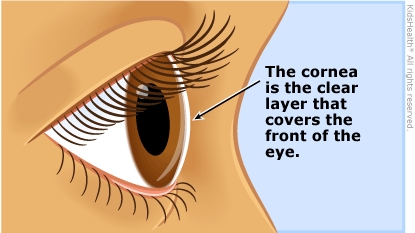A corneal abrasion is a scratch to the cornea, the clear layer that covers the front of the eye. A corneal abrasion can be painful, but it usually heals quickly and doesn't cause lasting problems. By using any drops or ointments as prescribed, you can help your child's eye get better.

How do kids get a corneal abrasion? Kids can get a corneal abrasion if:
- The cornea is scratched by a fingernail.
- The cornea is scraped by a tree branch.
- Tiny pieces of wood, glass, plastic, sand, or other objects get stuck under the eyelid.
- Contact lenses aren't used or cleaned properly.
Can corneal abrasions be prevented? To help prevent corneal abrasions, kids and teens should:
- Wear safety glasses or goggles when cutting wood, metal, or other materials.
- Wear safety glasses or goggles when doing high-impact sports, such as baseball, basketball, football, racquetball, soccer, wrestling, hockey, lacrosse, and paintball.
- Use and clean contact lenses as directed.




